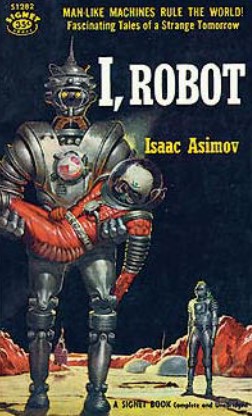One of the most common ‘jewish invention’ myths is the idea that a jew – specifically the jewish biochemist and science fiction writ er Isaac Asimov – created the famous ‘Three Laws of Robotics’ which are designed to protect human beings from robots becoming self-aware.
The ‘jewish invention’ claim is as follows:
‘Isaac Asimov – The Three Laws of Robotics
The Three Laws of Robotics — fundamental behavioral rules for artificial intelligence to prevent harm to humans — were first formulated by science fiction writer Isaac Asimov in 1942.’ (1)
Also, for those who don’t know or need a refresher these are the Three Laws of Robotics:
1. A robot may not injure a human being or, through inaction, allow a human being to come to harm.
2. A robot must obey the orders given it by human beings except where such orders would conflict with the First Law.
3. A robot must protect its own existence as long as such protection does not conflict with the First or Second Law.
Ironically compared to say other jews who were dishonest and utterly unscrupulous about stealing the work of non-jews and passing it off as their own with various degrees of success; (2) Asimov was rather honest about the fact that he didn’t come up with the Three Laws of Robotics but rather his friend John Campbell – the editor of the magazine ‘Astounding Science-Fiction’ – did.
As Asimov himself explains it in his 1979 autobiography of those years:
‘My meeting with Campbell on December 23, 1940, was of extreme importance to me. Handing in “Christmas on Ganymede” was of small account. It was rejected, and it deserved to be. What was far more important was that I wanted to write another robot story. This time I wanted to write a story about a robot that, through some mistake on the assembly line, turned out to be capable of reading minds.
Again, Campbell became interested and we talked it over at length – what complications would arise out of robotic telepathy, what a robot would be forced to lie about, how the matter could be resolved, and so on. At one point, Campbell said:
“Look, Asimov, in working this out, you have to realise that there are three rules that robots have to follow. In the first place, they can’t do any harm to human beings; in the second place, they have to obey orders without doing harm; in the third, they have to protect themselves, without doing harm or proving disobedient. Well…”
That was it. Those were the Three Laws of Robotics.’ (3)
Asimov goes on to explain further that:
‘And yet I heard the Three Laws first from John Campbell and I am always embarrassed to hear myself given the credit. Whenever I tried to tell Campbell himself, however, that he was the originator, he would always shake his head and grin and say, “No, Asimov, I picked them out of your stories and your discussions. You didn’t state them explicitly, but they were there.”
It’s true I had a remark that sounded like the First Law even in “Robbie,” but I think Campbell was just trying to do what he always did – let the writer have all the credit.’ (4)
Asimov here is quite clear that he didn’t come up with the Three Laws of Robotics but rather John Campbell did, while they were discussing the outline and logic of his new robot-centred science fiction short story in late December 1940.
He is further clear that – in his view – Campbell came up with the Three Laws of Robotics but Campbell was deliberately letting him take the credit for something that he didn’t create or invent because ‘Asimov inspired Campbell to come up with the Three Laws of Robotics’ – this is the ‘official’ line that was created much later by the novelist – and fellow contributor to Campbell’s ‘Astounding Science-Fiction’ – Randall Garrett, (5) but this attempt to place Asimov and Campbell in a symbiotic relationship in order to credit Asimov is simply dishonest.
Yes, it appears that Asimov’s idea for a robot story inspired Campell to come up with the Three Laws of Robotics and Asimov was Campbell’s amanuensis in this regard and so deserves credit as the man who inspired Cambell to create/invent the Three Laws of Robotics as well as being the first person to write them down, but it – and again Asimov is very clear on this point – was John Campbell who created/invented them not Isaac Asimov.
Thus we an see that despite the commonly believed myth that the famous Three Laws of Robotics are a ‘jewish invention’: they are in fact not.
References
(1) https://mnews.world/en/news/the-great-jews-and-their-inventions
(2) For example, please see my articles: https://karlradl14.substack.com/p/jewish-invention-myths-the-universal; https://karlradl14.substack.com/p/jewish-invention-myths-the-bubonic; https://karlradl14.substack.com/p/jewish-invention-myths-the-electron; https://karlradl14.substack.com/p/jewish-invention-myths-modern-computer; https://karlradl14.substack.com/p/jewish-invention-myths-the-laser
(3) Isaac Asimov, 1979, ‘In Memory Yet Green: The Autobiography of Isaac Asimov, 1920-1954’, 1st Edition, Avon: New York, pp. 285-286
(4) Ibid., pp. 286-287
(5) Ibid., p. 287
Karl’s SubstackRead More





 T1
T1



